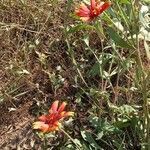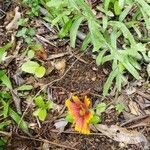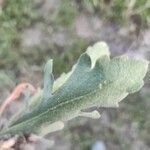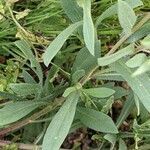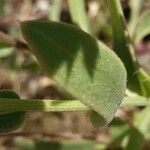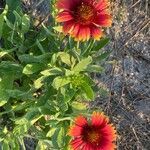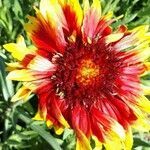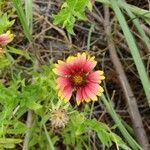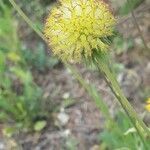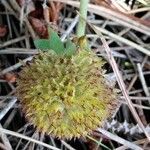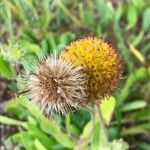Annuals (sometimes persisting), 5–35(–60+) cm. Leaves cauline; petiolar bases 0–3+ cm; blades linear, oblong, or spatulate, 1–5(–12) cm × 4–12(–35) mm, (bases of distal ± clasping) margins usually entire, sometimes toothed or lobed, faces closely strigillose or hirtellous to ± villous (hairs jointed). Peduncles 3–10(–20) cm. Phyllaries 18–28+, narrowly triangular-to linear-attenuate, 6–14+ mm, usually ciliate with jointed hairs. Receptacular setae 1.5–3 mm. Ray florets usually 8–14, rarely 0; corollas usually reddish to purplish proximally, yellow to orange distally, rarely yellow, reddish, or purplish throughout, 13–30+ mm. Disc florets 40–100+; corollas yellowish to purple or brown, often bicolored, tubes 0.8–1.2 mm, throats campanulate to urceolate, 3–4 mm, lobes deltate to ovate, often attenuate, 1–3+ mm, jointed hairs 0.3+ mm. Cypselae obpyramidal, 2–2.5 mm, hairs 1.5–2 mm, inserted at bases and on angles; pappi of 7–8 deltate to lanceolate, aristate scales 4–7 mm (scarious bases 1–2.5 × 0.7–1.3 mm). 2n = 34.
Herbs, annual, 10-60 cm. Leaves cauline, sessile to subsessile; blade linear, oblong, or spatulate, 5-10 cm × 4-12(-35) mm, densely strigillose or hirtellous to ± villous, margin usually entire, sometimes toothed or lobed. Phyllaries 18-28, narrowly triangular-attenuate to linear-attenuate, 6-14 mm, margin usually ciliate with jointed hairs. Receptacular setae 1.5-3 mm. Ray florets usually 8-14; corolla usually reddish to purplish proximally, yellow to orange distally, rarely yellow, reddish, or purplish throughout, 13-30 mm. Disk florets numerous; corolla yellowish to purple or brown, often bicolored; tube 0.8-1.2 mm; throat campanulate to urceolate, 3-4 mm; lobes deltate to ovate, often attenuate. Achenes obpyramidal, 2-2.5 mm; hairs 1.5-2 mm, inserted at base and on angles; pappus of 7 or 8 deltate to lanceolate, aristate scales 4-7 mm. Fl. May-Aug. 2n = 34.
Glandular-villous annual or sometimes short-lived perennial, 1–6 dm, simple to more often freely branched and with several or many heads, often decumbent at base, the littoral forms commonly somewhat succulent; disk 1–2.5 cm wide; rays purple or the tip yellow, mostly 1–2 cm; setae of the receptacle about equaling or only slightly exceeding the achenes; otherwise much like no. 1 [Gaillardia aristata Pursh]; 2n=34, 68. Dry, often sandy places, sometimes on sea-beaches; Mo. and s. Neb. to Colo., N.M., and n. Mex., and along the coast from Tex. to Fla. and se. Va. May–Sept. (G. drummondii; G. picta Sweet, the littoral phase, perhaps properly to be treated as a distinct var.)
Annual herb to 60 cm high. Stems with antrorse, eglandular hairs. Leaves lanceolate to elliptic, 3–8 cm long, 0.8–2 cm wide, entire to pinnatifid, acute, with eglandular hairs and sessile glands; lower leaves petiolate; upper leaves sessile. Capitula solitary or few; involucre 15–20 mm diam. at anthesis, 30–50-flowered; involucral bracts lanceolate, 7–11 mm long, acuminate; receptacle setae c. same length as achene. Ligules red and yellow. Disc corolla purple; tube 4–5 mm long; lobes subulate, 2.5–3.5 mm long, densely tomentose; anthers c. 3.5 mm long. Achenes 2.5–3 mm long, white, with long antrorse hairs on lower half. Pappus of 6–8 scales, 4–5.5 mm long; apex awn-like.
Annual herb, up to 0.5 m high; erect, branched, softly pubescent. Leaves alternate, usually sessile, oblong or spathulate, margins entire. Capitula radiate; several-flowered, usually solitary on long, nude peduncles, terminating branches; involucral bracts lanceolate, ciliate on margins and midline. Ray florets neuter, rarely female and fertile; corolla yellow, often bicoloured, strap-shaped, rarely irregularly enlarged. Disc florets bisexual; corolla yellow or purplish, tubular below, campanulate above, 5-toothed. Anthers with apical appendage acuminate. Style linear, truncate, penicillate. Pappus of 5 awned scales. Cypselae turbinate, villous.
Annual herb, up to 500 mm high. Leaves alternate, mostly sessile; blade oblong or narrowly obovate, up to 90 x 20 mm, margins entire, obscurely toothed or lobed. Heads radiate, solitary on long, nude peduncles terminating branch tips. Involucral bracts ± 3-seriate, lanceolate, appressed-hairy, ciliate on margins. Receptacle epaleate, setose. Flowers: ray florets yellow in upper half, purple-red in lower; disc florets yellow; Jan. Fruit with cypsela turbinate, villous. Pappus of long-awned scales.
Annual herb, up to 500 mm tall. Leaves alternate, mostly sessile, oblong or spathulate, margins entire, obscurely toothed or lobed. Heads solitary on long, nude peduncles terminating branch tips. Pappus of long-awned scales. Flowers with rays yellow in upper half, purple-red in lower, disc yellow.
